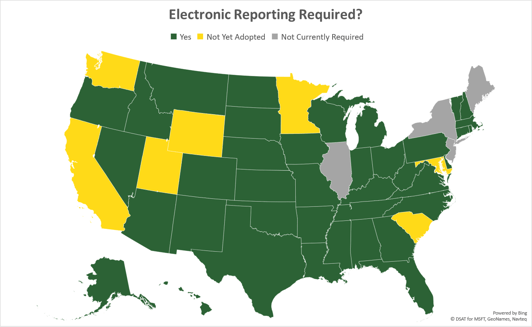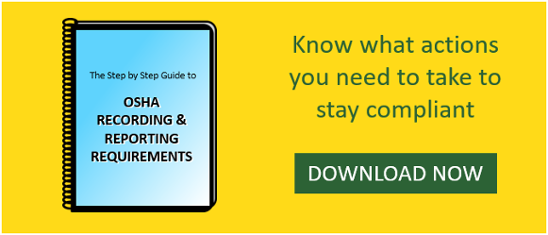Editor's Note: Updated Dec 18, 2017. OSHA pushed back the deadline from Dec 15 to Dec 31, and has said they will not take enforcement action on those who meet the Dec 31 deadline (see source here). Starting Jan 1, 2018, OSHA will no longer accept 2016 data.
OSHA just made an announcement on Dec 18 that they are extending the deadline to electronically file your safety incident data from Dec 1 to Dec 31 of 2017.
“What?!!” Was that your reaction? Or was it “Oh yeah, I have heard something about submitting my incident data online.” In either case, OSHA has tons of information all over the place about this, and it can be quite confusing to navigate this, let alone nerve racking, in order to meet OSHA compliance.
This blog post will relieve the pressure by walking you through the 6 key steps to know how it applies to you, and give you 2 immediate takeaways to take, to ensure OSHA compliance and avoid fines.
Warning: although some parts of this rule might NOT apply to you, there is 1 tidbit below that applies to everyone - be sure to read it!
If you want to skip the blog post and get the complete guide here, feel free to do so (it includes the info from this post and much more).

6 Critical Facts on the Electronic Reporting Rule
1. Why & What
Over the past year OSHA has released several tidbits about how they plan to use behavioral economics to “nudge” companies to become safer. What this means in layman’s terms is that they are collecting more safety incident data and will be making it publicly available, with the idea that companies will naturally focus more on safety. OSHA agrees with the data on the ROI of safety, and hence think this approach is a win-win for employers’ bottom lines and employees’ safety.
The rule requires certain employers to electronically submit injury and illness data that is already required to record (referred to as compliance reporting). Depending on the size of the operation, this data is either a summary or also a detailed list of every incident. Analysis of this data will enable OSHA to use its enforcement and compliance assistance resources more efficiently (see here for how OSHA determines its fines). Some of the data will also be posted publicly to the OSHA website, which is part of the behavioral economics strategy.
2. Who does it apply to
A. State AdoptionThe following states have not yet adopted the rule: CA, MD, MN, SC, UT, WA and WY. And for the following states, this new reporting is not currently required: IL, ME, NJ, and NY. This state list could change at any time; be sure to check with your state contact to ensure you know if your state is using the rule.
OSHA also stated: "OSHA State Plan states must adopt requirements that are substantially identical to the requirements in this final rule within 6 months after publication of this final rule". So, gear up!

We have written about the exemption that Ag has for 10 employees or less on OSHA enforcement, but that has little to nothing to do with this new rule. Here are the compliance reporting requirements for different sized establishments:
Warning: These requirements are based on size of establishment, NOT size of entire business (see our guide for more details!). A business might have to submit for multiple establishments.
- less than 20 employees
- do not need to electronically file.
- 20-249 employees in Agriculture & other high risk industries
- required to electronically file the 300A “Summary of Work-Related Injuries and Illnesses” report
- 250+ employees are required to electronically file:
- 300 - Log of Work-Related Injuries and Illnesses
- 300A - Summary of Work-Related Injuries and Illnesses
- 301 - Injury and Illness Incident Report
Employee count is defined as the total number of ANY type of worker at ANY time during the previous year, excluding owners under certain conditions - see our guide for details on this.
This year is special however for 250+ employee companies; see phase in information below.
3. Timeline of the Phase-In
Companies need to file their 2016 Form(s) by Dec 31, 2017. This year is a special case for the operations with more than 250+ employees: they only need to submit the 300A summary report.
Then 2017 Forms are required by July 1, 2018. 2018 & Beyond Form(s) are required by March 2 of following year.
Here is a quick referenece summary table:
| Year or Incident Date | Electronic Reporting Deadline |
| 2016 | December 31, 2017 |
| 2017 | July 1, 2018 |
| 2018 & Beyond | March 2 of following year |
4. How to submit the information
Go to the secure internet portal and you have 3 options:
- Manually enter data in webform
- Upload a CSV file to bulk-process
- Use API to automatically transmit data from a tracking system
See our step by step guide to navigating the OSHA recording and reporting requirements. It will save you time as you try to navigate this new rule & file your data.

5. Anti-Retaliation Rules – APPLIES TO EVERYONE
As part of this rule, OSHA wanted to make sure that employees understand the rights they have to report injuries and are not punished in any way. Your company procedure for reporting work-related injuries must be reasonable and not deter or discourage employees from reporting.
Although OSHA already prohibits anti-retaliation, previously the rule did not allow OSHA to act unless a complaint was received within 30 days of the retaliation. Now, OSHA can cite an employer even if there was NO complaint filed, OR if the employer has a program that deters reporting.
As a minimum requirement, employers need to post the “Job Safety and Health: It's the Law” poster (see the guide below) in the workplace in all applicable languages. THIS APPLIES TO ALL COMPANIES.
OSHA takes its rules seriously - see our 3 part series on #1 Why OSHA will come to your door, #2 What to do when they show up and #3 What they will be looking for.
6. Ongoing Review
OSHA has said that they will continue reviewing this new rule and will publish an update in 2018. When we hear about it, we will let you know about it and provide insights on what it means for Ag businesses. OSHA is bound to continue sharing these rules - be sure to subscribe to updates up & to the right of this blog!
Summary & Takeaways
Hopefully, that wasn't so bad, and now you should know what what applies to you and an overview of what to do.
In summary, OSHA is requiring electronic reporting of injury data for many companies (based on state & size), phased in over the next 2 years, and gives you 3 different ways to submit the information. Their ultimate goal is nudge employers to provide a safer workplace.
2 immediate takeaways:
- File your 2016 year 300A summary report by Dec 31 (if > 20 employees)
- Make employees aware of their rights with the OSHA job safety poster
If the electronic reporting portion does apply to YOU, we know all of this is probably very new and confusing. That is why we created the step by step guide to OSHA Recording and Reporting Requirements. Get it now below to know the employee count definition details, save time, get the step by step guides, the links to important resources like the job poster, state contacts, more source links, and more.
Please let us know if you have any questions or feedback in the comments below, or shoot me an email at drew@gooddayswork.ag.




